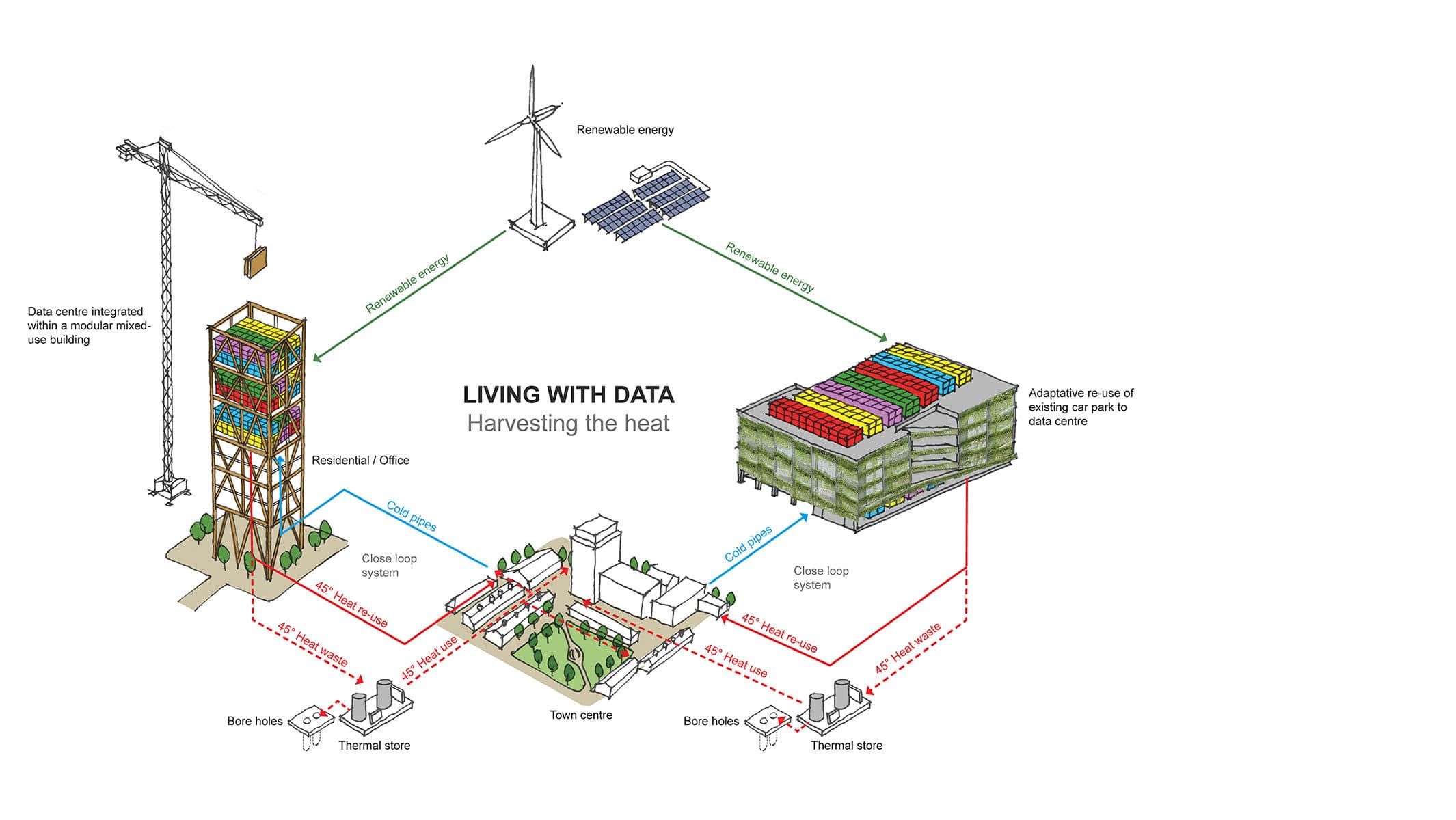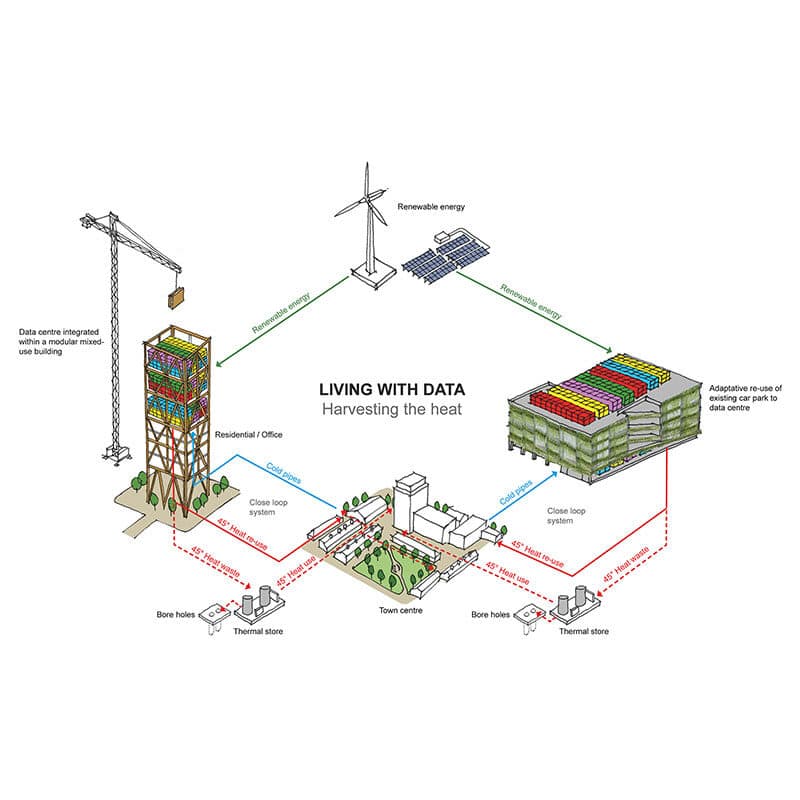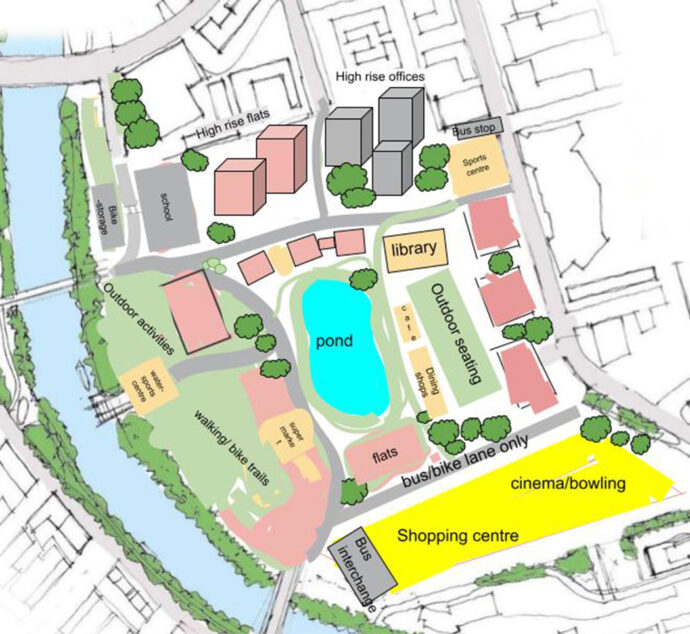Introduction
90% of the world’s data has been produced in just the last two years. In 2020, data centres accounted for around 1-3% of global electricity demand.
3DReid is working alongside CPW engineers on a strategy to reduce the Power Usage Effectiveness (PUE) of datacentres. Power usage effectiveness (PUE) is a ratio that describes how efficiently a computer data centre uses energy; specifically, how much energy is used by the computing equipment (in contrast to cooling and other overhead that supports the equipment). Data Centres using conventional cooling and ventilation methods typically achieve a PUE of 2.5 meaning the energy required to cool and run the facility is 2.5 times that delivered to the IT equipment. An ideal PUE ratio is 1, delivering a 100% of energy used direct to equipment use. With the latest generation of CPUs consuming close to 300 watts, and GPUs using upwards of 500 watts, the limits of air cooling are approaching. Therefore, liquid cooling offers a cost-effective way to keep the highest performing servers operating and reduce operating expenditure on an ongoing basis.
History of Data Centres
Historically, data was stored on personal devices within the home but with the advent of the internet and the requirement for larger amounts of stored data this has been relocated to cloud based storage in large centralised data centres.
These data centres have typically been located away from urban centres and require large amounts of energy to cool and run facilities. There is now a push towards reducing heat losses and carbon emissions within data centres as demand rapidly increases through our reliance on digital and social media and cloud based computing solutions.
Data Centre Issues
The issues surrounding the increase in data storage and energy consumption have a significant impact on our climate and society. Facilities are large and therefore require large volumes of carbon intensive materials such as concrete and steel and significant back-up energy systems to ensure constant service.
Climate
The world is in a climate crisis and the amount of carbon emissions produced from data centres is forecast to rise to an unacceptable 14% of total emissions by 2040. The centres are extremely power hungry in relation to their cooling of IT equipment and require several back-up power generators, which are usually diesel powered and have to be tested regularly, to ensure they always run.
Recently, new cooling techniques involving the evaporation of water have been utilised. Due to the high cooling demand, evaporative/adiabatic systems generally utilise enormous quantities of water which must also be a consideration when designing these systems. If innovative liquid cooling methods are adopted such as ‘Direct to Chip’ and ‘Immersive cooling’ and the waste heat is recovered (thermal heat capture), a PUE approaching 1.0 can be achieved. At present, many data centres are incongruously located in large areas of greenfield land in cooler rural areas producing huge amounts of waste heat as a by-product. Each of these requirements need to be tackled and generated in a more sustainable and carbon neutral way.
Society
Western society has increasingly become more reliant on consuming data for corporate and social uses. In addition, the developing world is becoming more reliant on data and connected to the internet on a massive scale. This is intensified by new technologies such as high speed 5G, Cryptocurrency and the recent creation of Facebook’s ‘Metaverse’.
The focus needs to shift to how we can begin to live with data in a more sustainable way. As the requirement for datacentres will only expand and inevitably begin to be incorporated into our cities, certain questions need to be asked:
- Do we need to use as much data as we are currently using?
- What can individuals do to reduce their ‘data footprint’?
- Can data centres be more successfully designed, located and integrated within our towns and cities?
Current Initiatives to reduce carbon footprint of running data centres
Today we can find some examples of data centres that recycle waste heat.
- In Paris, the heat produced by the servers of Telecity Concorcet data centre is used to heat an on-site arboretum.
- In Switzerland, IBM data centre is being used to heat a nearby leisure centre.
- In Finland, the data centre for IT services firm Academica is located underneath Uspenski Cathedral and warms 500 nearby large private houses.
These examples show a growing conscious move towards a sustainable approach to data centre design, however we still don’t see full integration of the data centres within our urban environments. The example of IBM and Academica data centres are more sustainable in the fact that they are supplying secondary existing heat requirements, thus reducing energy demand for neighbourhood developments.
Microsoft have recently been experimenting with locating small scale data centres underwater near coastal cities for cooling purposes. Whilst this proposal is bold, there are some issues to take into account; firstly, the fact that an object is being dropped in a body of water. If this were to become a large scale initiative could it contribute to the warming of oceans through dissipated waste heat? Even if not impacting greatly on global sea temperatures, what is the impact on the local marine environment?
Why throw heat away if it could be recovered and utilised elsewhere?
Also, a submerged data centre is not easily accessible for maintenance and removal. All efforts are focussed on the process of cooling, whilst ignoring impacts related to heat production and sustainable solutions to re-use the heat generated.
As part of its Net Carbon Zero Plan for 2050, the UK Government has targeted 100% of power to be generated by renewable sources by 2035. The electricity grid continues to de-carbonise as existing energy sources are decommissioned (coal power stations) and more renewable sources continue to be added (wind/solar). To achieve a carbon-neutral circular process, the energy consumed by the data centres should come from on-site or off-site renewable power generation. On-site generation would be ideal, however this energy production requires large areas of land so only data centres located in rural areas could achieve this. Integrating data centres within our urban centres requires the acceptance that they will be powered through off-site generation but renewable energy can still be produced off-site and fed into the grid. The main advantage within urban centres is the ability to effectively harvest the excess heat.
Is it possible to integrate data centres into our cities and communities?
Instead of locating in rural areas on greenfield sites, we are proposing to locate data centres on brownfield sites within city centres where all of the access, security and flood risk requirements can easily be managed. This has a number of advantages, the primary advantage of which is the harvesting of excess heat produced by cooling the IT equipment to heat the surrounding buildings.
We have focussed on two scenarios:
New-build modular structures
There is potential to create a new typology of mixed-use building, with the integration of a data centre into a modular tower building alongside uses such as office, residential or leisure. The data centre could be located at the top of the building, visible to the public, to serve as a reminder to society of how much data we are currently using.
POSITIVES – Potential to activate ground floors with these other usages and allows datacentres to still be secure above ground floor level
POSITIVES – Modular nature allows for future expansion and change of use or removal in the future if data centre provision needed to be expanded / reduced or repurposed in line with circular economy principles.
Energy required to power the centres can be offset by on and off-site renewables such as wind farms, PVs and bore holes.
Adaptive reuse
The process of taking existing buildings and adapting them to realise a new function. The example we think of is multi-storey car parks which will become increasingly redundant with the reduction of vehicles within our future cities.
POSITIVES – Capturing and re-purposing embodied carbon within existing buildings.
POSITIVES – Access to floorplates via facades for equipment installation and replacement.
POSITIVES – Structural loading capacity requires little or no additional strengthening/materials
POSITIVES – Community use to building within urban realm – no change from at ground floor from a street scape perspective.
POSITIVES – Ability to build secondary uses above such as residential; public or commercial for a symbiotic development.
CHALLENGES – Car parks for example have no active frontages, street frontages may not be activated still within city, although front of house areas such as Meet Me rooms and administration offices can be located at ground floor for activation.
CHALLENGES – Adaptation of datacentre equipment configuration is required to fit within lower floor to floor heights. Typical datacentres have a floor to floor hight of 3.5-4m vs. 2.5 m for car parks.
Having these data centres knitted into the urban fabric allows for the re-use of heat into the immediate context. Capturing the generated heat in an urban environment can be used for heating housing; public buildings or harnessed as a catalyst for waste processing and urban farm production, such as urban greenhouses used to produce food or carbon capturing flora. This, along with the potential for the energy production required to power the centres to be offset by offsite renewables such as wind farms, solar panels and bore holes.
Conclusion
It can no longer be ignored the fact that the climate is in crisis and the fact data centres and the consumption of data could be the greatest producer of carbon emissions in the near future. Unless society adopts a radically different approach to the data we create, shape and store, data centres will continue to be in significant demand.
Data centres could be more visible in our city. Therefore we, as designers and inhabitants of the planet it is imperative that we are part of the solution by taking responsibility for our data footprints by both reducing our consumption and improving the design and performance of these impactful facilities.











